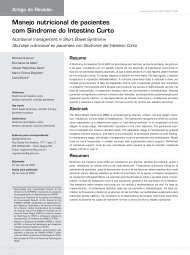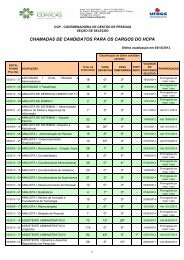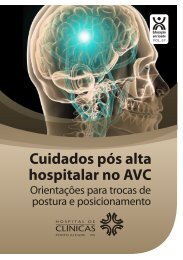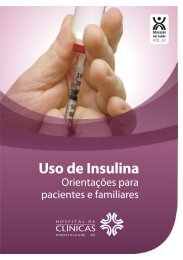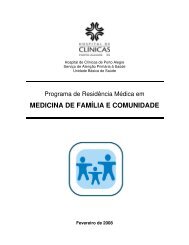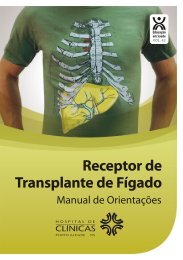Anais da 27º Semana CientÃfica - Hospital de ClÃnicas de Porto Alegre
Anais da 27º Semana CientÃfica - Hospital de ClÃnicas de Porto Alegre
Anais da 27º Semana CientÃfica - Hospital de ClÃnicas de Porto Alegre
You also want an ePaper? Increase the reach of your titles
YUMPU automatically turns print PDFs into web optimized ePapers that Google loves.
244<br />
Revista HCPA 2007; 27 (Supl.1)<br />
DETERMINAÇÃO DO SEXO FETAL ATRAVÉS DE UMA AMOSTRA DE SANGUE MATERNO.<br />
HUGO BOCK; ROBERTO GIUGLIANI, MARIA LUIZA SARAIVA-PEREIRA<br />
A presença <strong>de</strong> células fetais nuclea<strong>da</strong>s na corrente sangüínea <strong>da</strong> mãe já foi comprova<strong>da</strong> por vários estudos, mas o isolamento<br />
<strong>de</strong>ssas células é trabalhoso e <strong>de</strong>morado. Com o avanço <strong>da</strong>s tecnologias em biologia molecular, principalmente com a<br />
popularização <strong>da</strong> PCR, que <strong>de</strong>tecta até uma única molécula <strong>de</strong> DNA em uma amostra, foi possível comprovar a existência <strong>de</strong><br />
DNA fetal livre no plasma materno. A importância <strong>de</strong>sse achado está ligado principalmente a i<strong>de</strong>ntificação precoce do sexo fetal<br />
em famílias em risco para doenças genéticas <strong>de</strong> herança liga<strong>da</strong> ao sexo, como a hemofilia, a DMD, a síndrome <strong>de</strong> Menkes, entre<br />
outras. Este trabalho tem como objetivo introduzir uma metodologia <strong>de</strong> sexagem fetal pela análise <strong>de</strong> DNA obtido do plasma<br />
materno. A amostra foi composta por 64 mulheres grávi<strong>da</strong>s entre a 5ª e a 25ª semana <strong>de</strong> gestação. Desses indivíduos foi coleta<strong>da</strong><br />
uma amostra <strong>de</strong> 5 mL <strong>de</strong> sangue periférico em tubo com EDTA como anticoagulante, o plasma foi separado e o DNA nele<br />
circulante foi isolado utilizando-se um kit comercial. A amplificação do DNA foi feita por PCR em tempo real utilizando o<br />
sistema TaqMan® (Applied Biosystems), <strong>de</strong> uma região específica do cromossomo Y e <strong>de</strong> uma outra região do genoma humano<br />
como controle interno <strong>da</strong> reação. Através <strong>de</strong>ssa metodologia, foram encontrados 37 (57,8%) amostras do sexo masculino e 27<br />
(42,2%) amostras do sexo feminino. No grupo <strong>de</strong> amostras femininas, 3 (4,7%) apresentaram resultado falso negativo, sendo que<br />
2 (3,1%) <strong>de</strong>ssas amostras eram proveniente <strong>de</strong> mulheres com menos <strong>de</strong> 8 semanas <strong>de</strong> gestação. A metodologia <strong>de</strong>senvolvi<strong>da</strong> e<br />
testa<strong>da</strong> se mostrou foi eficiente e a<strong>de</strong>qua<strong>da</strong> para ser introduzi<strong>da</strong> como importante ferramenta <strong>de</strong> uso clínico, visto que reduz a<br />
necessi<strong>da</strong><strong>de</strong> <strong>de</strong> métodos invasivos para diagnóstico <strong>de</strong> doenças no período pré-natal (Apoio: CNPq).<br />
CHARACTERIZATION OF AT RISK PATIENTS FOR HEREDITARY BREAST AND OVARIAN CANCER CONSIDERING<br />
PRESENCE AND FREQUENCY OF GENIC REARRANGEMENTS IN BRCA1<br />
INGRID PETRONI EWALD; EDENIR INÊZ PALMERO, PATRICIA IZETTI LISBOA RIBEIRO, CARLOS ALBERTO<br />
MOREIRA FILHO , DANIELLE RENZONI , MARIA ISABEL WADDINGTON ACHATZ , FERNANDO REGLA VARGAS ,<br />
MIGUEL MOREIRA , ROBERTO GIUGLIANI , PATRICIA ASHTON-PROLLA .<br />
Introduction: In the world-wi<strong>de</strong> context, breast cancer is the most common cancer and it is the first tumor in frequency among<br />
women. In Brazil, it represents the first cause of <strong>de</strong>ath in brazilian women of all ages. In relation to the Hereditary Breast and<br />
Ovarian Cancer (HBOC Syndrome) (5-10% of all breast cancer), BRCA-1 and BRCA-2 are the main genes involved. Families<br />
with clinical criteria of HBOC but with negative BRCA1/2 mutations should be tested for large gene rearrangements since these<br />
abnormalities seems to be responsible for, at least, 10% of all cases. Amongst these rearrangements, large <strong>de</strong>letions and/or<br />
duplications were recently associated to HBOC. Objectives: To verify the frequency of gene rearrangements in BRCA1 in<br />
brazilian individuals with the clinical diagnosis of HBOC comparing two different techniques. Materials and Methods: Forty<br />
patients with breast or ovarian cancer, fulfilling the ASCO criteria and/or with a mutation probability of at least 30% by pe<strong>de</strong>gree<br />
analysis and with the use of known methods (Myriad Mutation Prevalence Tables and the Penn II mo<strong>de</strong>l) were inclu<strong>de</strong>d. Long-<br />
Range PCR and MLPA (Multiplex Ligation-<strong>de</strong>pen<strong>de</strong>nt Probe Amplification) were used to <strong>de</strong>tect gene rearrangements. Results<br />
and Conclusions: Currently, 20 patients have been analysed. Additional results will be presented.<br />
TERMOESTABILIDADE DA ENZIMA QUITOTRIOSIDASE: COMPARAÇÃO ENTRE PACIENTES COM A DOENÇA DE<br />
GAUCHER COM E SEM TRATAMENTO DE REPOSIÇÃO ENZIMÁTICA E INDIVÍDUOS NORMAIS<br />
ALESSANDRO WAJNER; MICHELIN K.; ANDRADE C.V.; BURIN M.G.; PIRES R.F.; GIUGLIANI R. AND COELHO J.C.<br />
Introdução: A enzima Quitotriosi<strong>da</strong>se (QT) faz parte <strong>da</strong> família <strong>da</strong>s glicosilhidrolases e tem função <strong>de</strong> <strong>de</strong>gra<strong>da</strong>ção <strong>de</strong> quitina. A<br />
ativi<strong>da</strong><strong>de</strong> <strong>da</strong> QT é freqüentemente muito aumenta<strong>da</strong> em plasma <strong>de</strong> pacientes com a Doença <strong>de</strong> Gaucher. Além disso, também se<br />
encontra um aumento mo<strong>de</strong>rado na ativi<strong>da</strong><strong>de</strong> <strong>da</strong> QT em pacientes com Doença <strong>de</strong> Niemann-Pick, Gangliosidose-GM1 e Doença<br />
<strong>de</strong> Krabbe. O objetivo do trabalho foi investigar a termoestabili<strong>da</strong><strong>de</strong> <strong>da</strong> QT em indivíduos normais e em pacientes com a Doença<br />
<strong>de</strong> Gaucher com e sem tratamento <strong>de</strong> reposição enzimática (TRE). Material e Métodos: foi <strong>de</strong>terminado através <strong>de</strong> um método<br />
fluorimétrico a ativi<strong>da</strong><strong>de</strong> e a termoestabili<strong>da</strong><strong>de</strong> <strong>da</strong> QT em plasma <strong>de</strong> controles, pacientes com a Doença <strong>de</strong> Gaucher com TRE<br />
(GE) e pacientes com a doença <strong>de</strong> Gaucher sem TRE (DG). Resultados: A ativi<strong>da</strong><strong>de</strong> <strong>da</strong> QT no grupo DG e GE foi,<br />
respectivamente, 51 vezes e 53 vezes mais alta comparado à ativi<strong>da</strong><strong>de</strong> <strong>de</strong> indivíduos normais. No grupo DG observou-se uma<br />
maior estabili<strong>da</strong><strong>de</strong> <strong>da</strong> enzima ao calor quando incuba<strong>da</strong> por 10, 15 e 25 minutos a 60oC, em comparação à enzima do grupo GE e<br />
do grupo controle. Os resultados mostraram que a curva <strong>de</strong> termoestabili<strong>da</strong><strong>de</strong> do grupo GE foi semelhante àquela <strong>de</strong> indivíduos<br />
normais nos minutos finais (10, 15 e 25 minutos) <strong>de</strong> incubação. Estudos cinéticos <strong>da</strong> enzima quitotriosi<strong>da</strong>se po<strong>de</strong>m auxiliar para<br />
um melhor entendimento <strong>da</strong> patofisiologia <strong>da</strong> Doença <strong>de</strong> Gaucher.<br />
IDENTIFICAÇÃO DE MUTAÇÕES NO GENE DA ARILSULFATASE A ATRAVÉS DE PCR EM TEMPO REAL<br />
ETIENE AQUINO CARPES; HUGO BOCK; ROBERTO GIUGLIANI; MARIA LUIZA SARAIVA PEREIRA<br />
A arilsulfatase A (ASA), enzima lisossômica que catalisa o primeiro passo <strong>da</strong> <strong>de</strong>gra<strong>da</strong>ção do cerebrosí<strong>de</strong>o sulfato, é codifica<strong>da</strong><br />
por um gene localizado no cromossomo 22, o qual é formado por oito exons. Alterações na seqüência normal po<strong>de</strong>m estar<br />
associa<strong>da</strong>s a uma doença hereditária <strong>de</strong>nomina<strong>da</strong> leucodistrofia metacromática (LDM), caracteriza<strong>da</strong> pelo acúmulo <strong>de</strong><br />
cerebrosí<strong>de</strong>o sulfato nos tecidos, ou à pseudo<strong>de</strong>ficiência <strong>de</strong> ASA (PD-ASA). As mutações 459+1G>A e P426L são associa<strong>da</strong>s à<br />
LDM enquanto as mutações N350S e 1524+95A>G à PD-ASA. O objetivo <strong>de</strong>ste trabalho foi introduzir e vali<strong>da</strong>r uma<br />
metodologia basea<strong>da</strong> em PCR em tempo real para i<strong>de</strong>ntificação <strong>de</strong>stas mutações. Nesse estudo, foram avaliados (i) um grupo<br />
controle composto por 62 indivíduos e (ii) um grupo teste composto por amostras <strong>de</strong> DNA <strong>de</strong> 200 indivíduos normais, sadios e<br />
sem suspeita clínica <strong>de</strong> LDM. O DNA foi isolado a partir <strong>de</strong> uma amostra <strong>de</strong> sangue com o kit GFX Genomic Blood DNA<br />
Purification (GE Healthcare) e quantificado pelo método fluorimétrico. As mutações foram analisa<strong>da</strong>s pelo sistema TaqMan no<br />
equipamento ABI 7500 PCR System (Applied Biosystems). Os primers e as son<strong>da</strong>s foram <strong>de</strong>senhados no programa Primer<br />
Express versão 2.0 (Applied Biosystems). A vali<strong>da</strong>ção do método foi realiza<strong>da</strong> através <strong>da</strong> confirmação dos resultados no grupo




